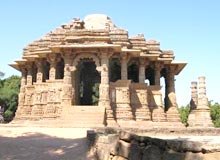In Modhera, the Sun Temple is one of the few temples dedicated to the Sun God. Situated on the banks of the river Pushpavati in Modhera, the Sun Temple is easily accessible from Ahmedabad, Gujarat's largest city. The closest station in Ahmedabad is located in Modera, which is situated 102 km away. Regular bus services are also available from Ahmedabad to Modhera. The nearest railway station is sitting in Mehsana, which is only 25 kilometers away.
In 1026, the temple was built by King Bhimdev of the Solanki dynasty (considered to be descendant of Sun God's descendant). This ancient temple revives the memories of Sun Temple in Konark in Orissa. Pointing to the pages of history, see the mention of Modera in texts such as Skanda Purana and Brahma Purana. The area around Modhera became known as the religion of the religion (forest of religion) and Lord Rama blessed this place.
Architecture
The magnificent architecture of the temple is one of its own class. The temple consists of three different, axial-coalition and integrated components. According to the Konark temple, this shrine has been prepared in a manner that the first ray of the sun should be placed on the image of the sun. The temple was looted by Mahmud Ghazni; Still Vaastu grandiosity is not missing. There is no matter what, however, provide a great attraction to see the remains.
Standing on a high platform, the temple appears to be majestic with its grand structure. However, spiers are out of sight, but 'Toranas' (Archways) which overshadow the absence of spiers or shikhars leading to the main hall. Exterior walls are engraved with complex carvings, boast about art mastery in those times. Every single inch of the structure is covered with sculpture patterns of God, Goddess, birds, animals and flowers. Actually, the Sun Temple is divided into three parts, i.e. the sun cistern, the assembly hall and the gad pavilion.
Surya Kund
A deep step tank is in front of the Suryakund temple. The name of the tank was named after Lord Sun (Sun God). In earlier times, this 100 square meter rectangular tank was used to store pure water. Prior to going to the temple, devotees were stopped here for formal bathing. There are fewer than 108 Devasthanas in the stages of this tank, including the temple dedicated to Lord Ganesha, Lord Shiva, Sheetla Mata and many others. In front of this tank, a huge 'Torana' (archway) leads to the Pavilion.
**Sabha Mandap**
Indeed, the meeting pavilion is referred to in an assembly hall where religious conferences and conferences are organized. This hall is open from all four sides and has 52 delicate carved pillars. The complex carvings show scenes of scenes from Ramayana, Mahabharata (Indian epic) and Lord Krishna's life. To come to the Faculty of Sanskar, one has to cross the pillars and the arches.
Guda Mandap
The Gauda Pavilion is a holy place which is supported by the lotus base. Once, this hall used the idol of Sun God in the house; the hall was designed in a way so that the first glimpse of the statue is found on one of the equinoxes. Though the statue was plundered by Mahmud Ghazni, but the walls represent Sun God in 12 different aspects of each month. In the carved walls, aspects of human life have been depicted as the vicious cycle of birth and death. The excuse of this hall was rebuilt in recent years, despite the fact that the roof was already broken up on the C-Uda Pavilion.
Festival
Modera Dance Festival is the main festival celebrated by the Sun Temple. This dance festival is organized to keep Indian traditions and culture alive. It is held every year in the third week of January. The classical dance form in the premises of this temple revives the royal atmosphere during this period. Gujarat Tourism organizes this event to promote tourism at this place.
I am really starting to think that we need to make India a tourist hotspot.
The history we have is unparalleled and not many countries have such a rich culture.